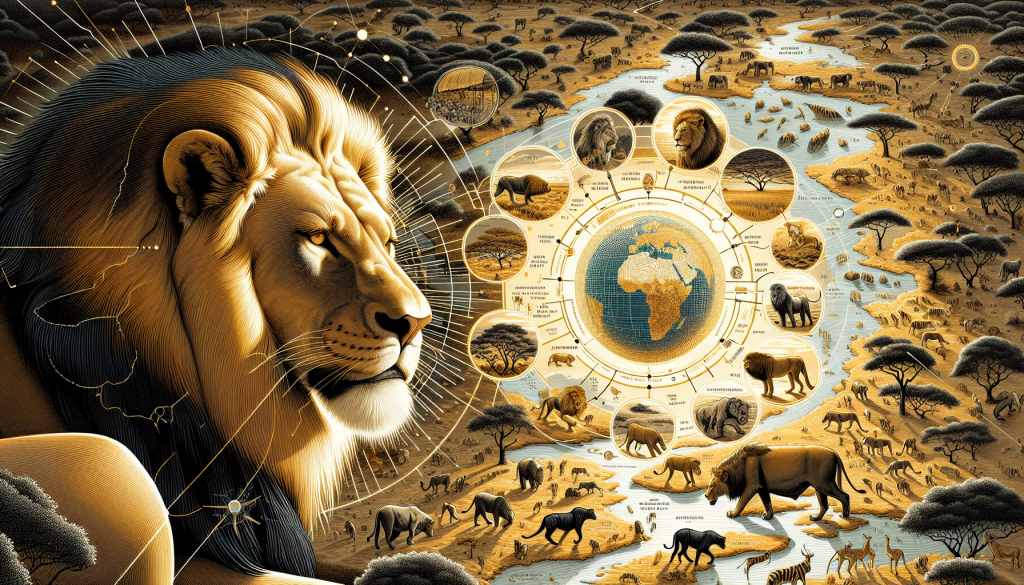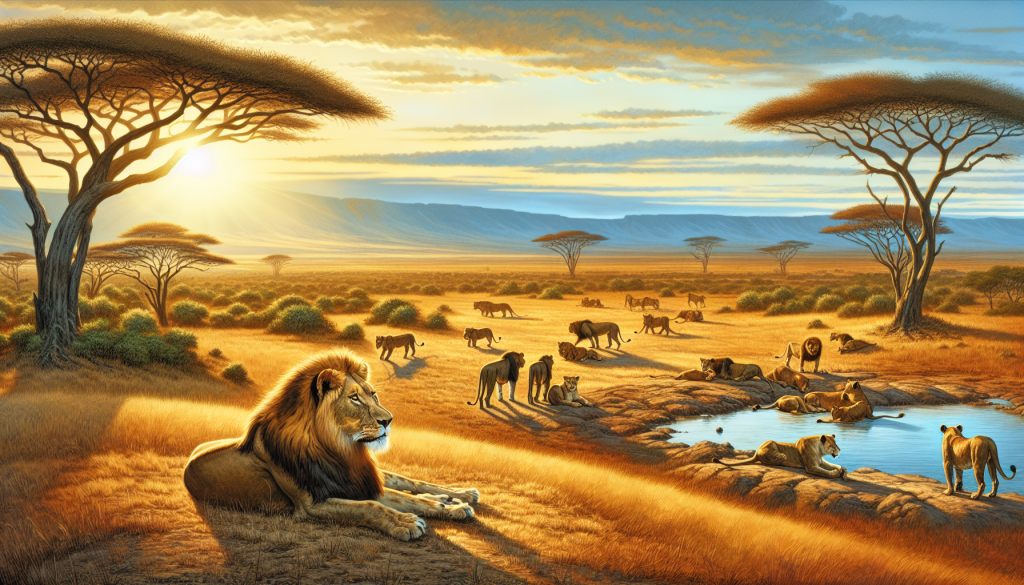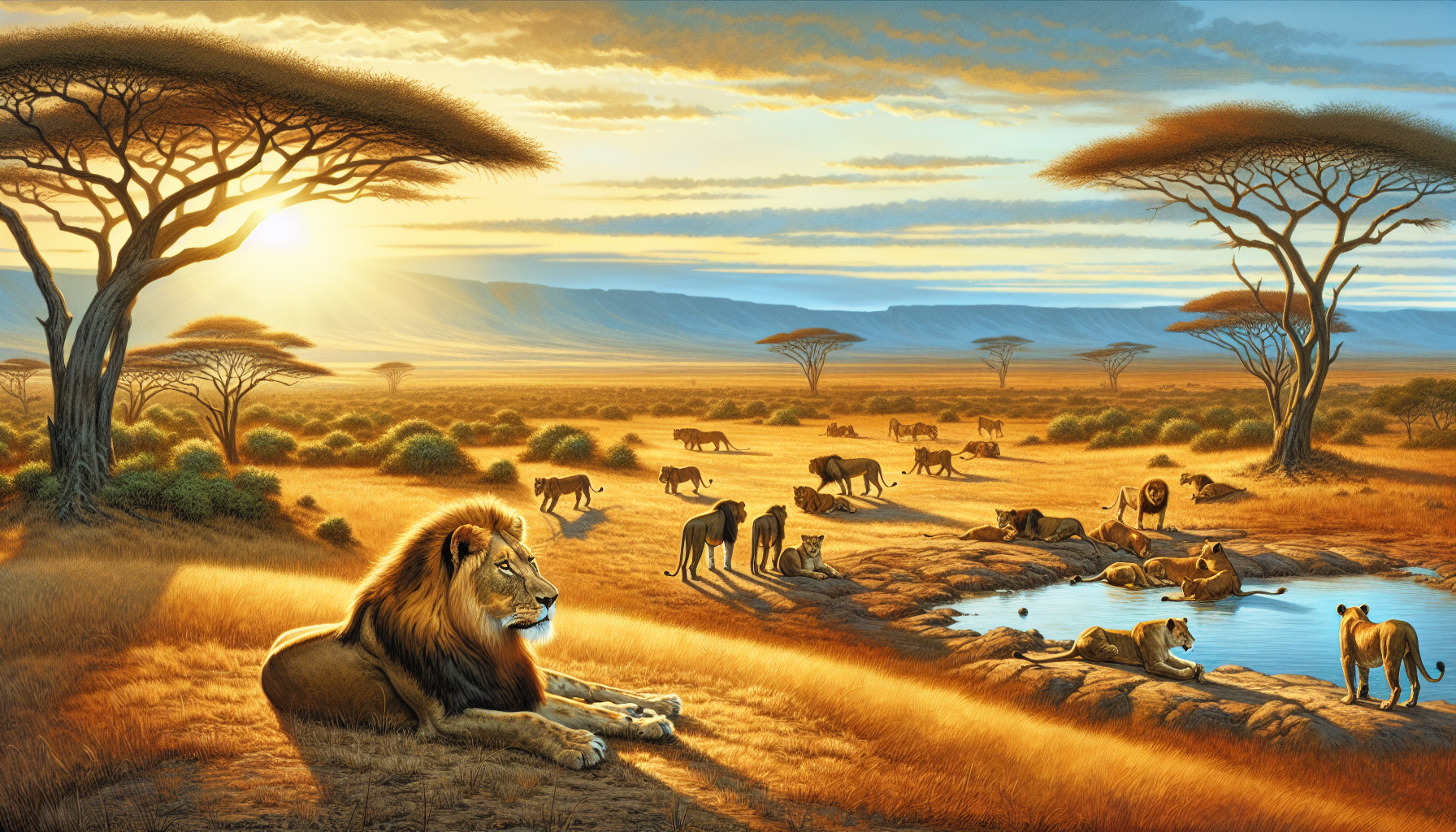Alright, so picture this: you’re flipping through the pages of an encyclopedia, searching for some interesting nuggets of information. Suddenly, you stumble upon a section titled “Lion Territories: The Encyclopedia’s Geographic Insights.” Intrigued, you delve into the article, eager to explore the world of these majestic creatures and uncover the fascinating details about their vast territories. From the vast plains of Africa to the arid landscapes of India, get ready to embark on a captivating journey through the realms of the mighty lions and their unique geographic insights.

Introduction
Welcome to “Lion Territories: The Encyclopedia’s Geographic Insights.” In this article, we will dive into the fascinating world of lion behavior and explore their distribution, habitat requirements, territorial behavior, interaction between territories, population dynamics, and the threats they face. Lions are majestic creatures that have captured the imagination of humans for centuries, and understanding their territories is crucial for their conservation. So, let’s embark on this journey and discover the intricate details of lion territories.
Distribution of Lions
Global Distribution
Lions, scientifically known as Panthera leo, have historically had a widespread distribution across various continents. However, today they are found only in parts of Africa and a small population in the Gir Forest of India. In Africa, lion populations can be found in countries like Kenya, Tanzania, South Africa, Botswana, and Zimbabwe, to name a few. The African lion, with its iconic presence, symbolizes the vast savannahs and wilderness of the continent.
Regional Distribution
Within Africa, lions are not uniformly distributed but have distinct regional variations. For instance, the East African region, including Serengeti National Park and Maasai Mara National Reserve, is known to have significant lion populations. On the other hand, regions like West Africa have experienced significant declines in lion numbers and face conservation challenges.
Habitat Requirements
Savannahs and Grasslands
Lions are well adapted to a variety of habitats, but they predominantly thrive in savannahs and grasslands. The open plains provide them with the necessary visibility to spot prey and the maneuverability required for successful hunting. The presence of ungulates, such as zebras and wildebeests, in these habitats ensures a reliable food source for the lions.
Woodlands and Scrublands
Aside from savannahs, lions also inhabit woodlands and scrublands, particularly in areas where there is a mix of open grassy areas and patches of denser vegetation. These habitats, with scattered trees and bushes, offer lions shade during hot days and act as ideal hunting grounds for stealthy ambushes.
Territorial Behavior
Definition and Importance
Territorial behavior is a fundamental aspect of lion social structure, where a group of lions, called a pride, defends a specific area against intruders. Lions defend their territories for various reasons, including securing resources like food and water, protecting their pride members, and ensuring reproductive success. It plays a crucial role in maintaining stability within lion populations.
Formation of Territories
Lions typically establish territories through a combination of physical defense and vocal communication. Male lions, or “coalition males,” often work together to defend their territory against rival coalitions. They mark their boundaries using scent markings and roaring, clearly indicating to other lions that the area is occupied.
Territory Marking
Territory marking is an essential aspect of lion behavior. Lions use scent marking techniques to communicate their presence and assert territorial ownership. They may mark their boundaries with urine, feces, or by scratching trees. These scent markings act as a deterrent, signaling to other lions that the area is already claimed.

Size and Shape of Territories
Factors Influencing Territory Size
The size of a lion’s territory varies and is influenced by multiple factors, including prey availability, habitat quality, and lion population density. In areas with abundant prey and favorable conditions, territories tend to be smaller, as lions can easily sustain themselves. Conversely, in areas with scarce resources, territories may be larger to accommodate the search for prey over a larger range.
Variation in Territory Shape
Lion territories can take different shapes depending on the landscape and availability of resources. In open grasslands, territories might be more circular due to the abundant visibility, while in habitats with dense vegetation, territories can be elongated to maximize hunting opportunities.
Interaction between Territories
Boundary Defense
Lions exhibit territorial defense by actively patrolling and marking their territory boundaries. They guard these boundaries against intruding individuals or rival prides. When confronted with boundary intruders, vocal confrontations, physical fights, and scent marking are common territorial defense mechanisms displayed by lions.
Intrusion and Disputes
Territorial boundaries are not always respected, and territorial disputes can occur when one pride attempts to encroach upon the territory of another. These disputes can escalate into intense fights, sometimes resulting in injuries or even death. Internal conflicts within a pride can also arise if coalition males challenge the dominant male for control.
Territorial Overlap
In some cases, territories of different prides or individual lions may overlap to an extent. Overlapping territories can create conflict zones, leading to increased competition for resources and potential clashes. However, territorial boundaries are usually respected, and the level of tolerance between neighboring prides can vary depending on the availability of prey and other resources.

Effect of Lion Density on Territories
Density-Dependent Factors
The density of lion populations can affect the size and shape of territories. In areas with high lion population densities, territories are often smaller and more fragmented due to the increased competition for resources. Conversely, in areas with lower densities, lions may have larger territories, allowing for greater access to prey and reducing the need for territorial disputes.
Competition and Resource Partitioning
In regions with high lion densities, competition for food and water becomes fiercer. Lions exhibit resource partitioning, where individuals within a pride coordinate their hunting strategies and target different prey species based on their size, speed, and vulnerability. This helps reduce competition within the pride and ensures a more efficient utilization of available resources.
Lion Population Dynamics
Fluctuations and Migration
Lion populations experience natural fluctuations in size due to various factors such as disease outbreaks, changes in prey abundance, and environmental conditions. During times of decline, lions may migrate to find new territories with more abundant resources or to establish new prides. Migration can result in changes to the distribution and composition of lion populations.
Dispersal and Establishment of New Territories
Sub-adult male lions usually disperse from their natal pride when they reach sexual maturity. These dispersing individuals search for unoccupied territories or prides where they can establish themselves as the dominant male. The establishment of new territories plays a vital role in maintaining genetic diversity and promoting the survival of lion populations.

Threats to Lion Territories
Human-Wildlife Conflict
As human populations expand and encroach upon lion habitats, conflicts arise. Livestock predation can lead to retaliatory killings by farmers, posing a significant threat to lion populations. Moreover, the fragmentation of lion habitats due to human activities can further disrupt their territorial dynamics and increase the chances of territorial disputes.
Habitat Loss and Fragmentation
Lions require vast areas to roam and hunt, but habitat loss and fragmentation have been shrinking their territories. Deforestation, urbanization, and the conversion of natural lands into agricultural areas have significantly reduced the available habitat for lions. This loss of territory not only affects lions but also disrupts entire ecosystems.
Illegal Wildlife Trade
Poaching of lions and the illegal trade of their body parts add to the pressures faced by these majestic creatures. The demand for lion bones, skins, and other body parts in the black market drives poaching activities. This illegal trade not only depletes lion populations but also undermines conservation efforts aimed at protecting their territories.
Conclusion
Understanding lion territories is crucial for their conservation and the preservation of their unique ecosystems. The distribution of lions, their habitat requirements, territorial behavior, and the various factors influencing their territories provide valuable insights into their survival in a continuously changing world. By addressing the threats they face, such as human-wildlife conflict, habitat loss, and illegal wildlife trade, we can ensure that the magnificent lion continues to reign supreme in its territories for generations to come.


